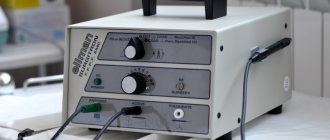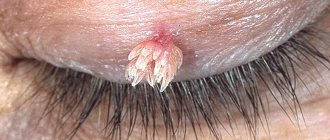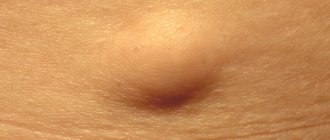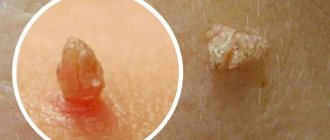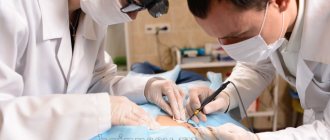After removal of the papilloma, careful care of the operated area is necessary, since infections may attach to the wound. The crust that forms during the healing period should not be wetted, overheated in the sun, or subjected to mechanical stress. Young skin after the scab has fallen off also needs careful handling. How to treat the damaged area after papilloma removal should be advised by the specialist who performed the procedure. As a rule, various antiseptics are prescribed in combination with vitamin therapy.
Features of papillomas
Papillomas can be of the following types: ordinary or vulgar warts, filiform (the most common type), flat, genital warts, plantar warts, juvenile warts. A dermatologist diagnoses and treats papillomas.
Most often, papillomas are localized in the armpits and inguinal folds, hands, on the surface of the foot, neck, under the mammary glands in women, as well as on the genitals. Papillomas located on the mucous membranes of internal organs are very dangerous; they can cause ulceration or bleeding. As a rule, papillomas that have a pronounced cosmetic defect are removed with a laser, i.e. which are located in open areas of the body, as well as those with a high risk of cancer.
How to prevent complications after papilloma removal
As a rule, after removal of papilloma, complications arise as a result of improper wound care. Scarring and long recovery times are most common when the immune system is weak. In some cases, infectious processes may occur accompanied by purulent discharge. To prevent such consequences, you should strictly adhere to the recommendations of the specialist who was involved in eliminating the skin formation. The list of medications is compiled depending on individual indicators - the location of the wound, the condition of the skin and other characteristics, but it must include antiseptic and anti-inflammatory drugs.
How to treat the wound surface after papilloma removal? Solutions of brilliant green, iodine and potassium permanganate have a disinfecting effect. After peeling off the crust, one percent hydrocortisone ointment can be prescribed, which is applied twice a day to the healed wound for 10 days.
During the rehabilitation period, it is important to increase the regenerative function of the skin, improve its elasticity and resistance to aggressive environmental factors. To do this, use solutions containing vitamins A and E. Hyaluronic acid, which is part of some creams and gels, creates a thin film on the surface of the skin, which, without interfering with oxygen exchange, stimulates the synthesis of collagen and elastin, and also revitalizes rough tissue. Gentle peeling with glycolic acid removes dead particles and smoothes the skin structure without damaging it.
After removing the papilloma, it is necessary to promptly normalize the production of elastin and collagen for the formation of connective tissue, and this is only possible with intensive nutrition of the skin. Vitamins, minerals and amino acids entering the body significantly contribute to healing and tissue regeneration.
Radical elimination of skin formations always entails the risk of further complications, so it is better to contact experienced surgeons rather than a beauty salon. You can avoid adverse consequences by strictly following all medical instructions and providing your skin with gentle treatment and careful care.
When is it necessary to remove papilloma?
Benign skin tumors cannot always be removed; sometimes observation and regular examinations are sufficient. The most common indications for removal are the following:
- papillomas located on visible parts of the body and causing psychological discomfort;
- papillomas that are constantly injured by clothing, jewelry, and a comb;
- neoplasms that increase in size, tend to spread, change size, shape and color;
- papillomas located in the intimate area or soles;
- if the tumor begins to hurt, itch or bleed.
Causes of papilloma
Growths on the skin appear under the influence of the human papillomavirus. One name hides about 100 strains of viruses that provoke the emergence of neoplasms of a wide variety of shapes, colors and sizes. These viruses enter the skin or mucous membranes and remain forever.
At the moment, pharmacists are not able to provide a drug that can get rid of this pathogen. But doctors have found ways to combat HPV, which we’ll talk about a little later.
For a long time, the human defense system is able to inhibit the vital activity of the virus and therefore the first symptoms of the disease appear after a week or even years. It all depends on how strong a person’s immunity is.
If the immune system is able to cope with the virus, then why do papillomas appear? As mentioned above, the virus remains in the body forever and as soon as the protective system is weakened, it immediately becomes active and generates growths on the skin.
Immunity weakens for the following reasons:
- Hormonal imbalances (pregnancy, breastfeeding, taking hormonal medications).
- Presence of bad habits (drug addiction, smoking, alcoholism).
- Unbalanced diet.
- Exacerbation of chronic or congenital diseases.
- Excess weight.
- Long-term use of medications.
- Promiscuous sexual intercourse.
- Frequent colds.
If the human body is exposed to these factors, then neoplasms appear. Doctors recommend removing papillomas, although they do not endanger human life.
Preparation and carrying out laser removal
Laser removal is preceded by a thorough examination and examination of the tumor. The doctor must be sure of its benign quality; in case of any doubts and the borderline state of the cells, laser technology is not used, but a surgical operation is performed.
During the procedure, under the influence of a laser, heating and layer-by-layer destruction of neoplasm cells occur, so it is impossible to take biological material for subsequent research. Additionally, the doctor surveys the patient about possible contraindications to the procedure, and also conducts a number of studies (blood tests).
No special preparation is required for the procedure. At the appointed time, the patient comes to the specialist, the operation includes the following stages:
- Disinfection of the surgical field.
- Conducting anesthesia (if necessary). For this, an injection, gel or spray is used.
- Installation of the device to the required laser length.
- Layer-by-layer evaporation of the neoplasm.
- Treat with an antiseptic and apply a bandage if necessary.
To avoid relapse of the disease, it is necessary to carry out antiviral therapy, as well as take immunomodulating and immunostimulating drugs to strengthen the immune system.
Complications
Even with the use of the most modern methods for removing papillomas, complications may arise after the procedure. Usually all the consequences boil down to redness, swelling and mild pain at the site of exposure. Such phenomena disappear after a few days. However, in some cases, this may be accompanied by the appearance of scars or spots in the area of papilloma removal. This can happen when:
- the location of the growth deep in the skin;
- choosing a removal method that does not correspond to the shape or size of the papilloma;
- lack of professionalism of the doctor;
- features of the procedure.
Also rare, but the most dangerous complication is wound infection. This can happen if the method of removing papilloma does not involve immediate tissue sealing or if the wound was poorly treated at the initial stage. In this case, you must consult a doctor for therapy.
Post-procedure care
For a quick and complete recovery and to avoid possible complications, the following measures are recommended:
- avoid contact with water in the first 2-3 days;
- Do not remove the crust that has formed (it will fall off on its own);
- Treat the wound with an antiseptic 2 times a day;
- protect the manipulation site from injury;
- wounds and new skin formed must be protected from ultraviolet radiation;
- refrain from shaving and epilation if the papilloma was in this area until complete healing.
Why remove warts and growths
There are several consequences that can occur if emerging papillomas are not treated in time.
- Some neoplasms arise under the influence of oncogenic viruses. Such growths easily degenerate into a malignant formation, and as a result, cancer develops.
- Typically, papillomas appear in places where the skin comes into contact with the fabric of clothing. This means that the growth is constantly being damaged. A small wound or crack is an open gate for secondary infection. Damaged papillomas do not heal well, and sometimes a scar can form there. In the worst case, suppuration may appear, which can lead to blood poisoning.
- Often patients turn to the doctor when the disease is very advanced, then there are so many growths that it is better to choose surgical removal. Doctors choose this method in the most extreme cases.
- Lack of treatment is also dangerous because you can infect your family and friends.
Benefits of laser papillomas removal
Laser removal of papillomas has long been used to remove skin tumors, because this method has many advantages:
- Excellent result. Laser destruction removes the tumor completely, there is no risk of relapse.
- Minimum of unpleasant or painful sensations. The procedure is carried out using local anesthesia and there is no discomfort or pain.
- Speed of the procedure. Laser destruction of papillomas takes no more than 5 minutes to remove one tumor
- Minimal trauma. The laser beam has a directed effect and acts only on the cells of the formation, without affecting nearby tissues.
- No postoperative scars or scars. After laser removal, a small crust remains at the site of the papilloma, which disappears on its own within 1.5-2 weeks. New, intact skin appears at the site of formation.
- Versatility. Due to the precision of the laser, this method can be used on any part of the body, including areas with thin and sensitive skin, mucous membranes, intimate area, eyelid skin, etc.
- No rehabilitation period. The procedure is performed on an outpatient basis, after which you can lead your normal lifestyle.
- Minimal risk of postoperative bleeding. The action of the laser coagulates blood vessels, which eliminates the risk of bleeding.
How to care for the wound after papilloma removal
The wound after removal of the papilloma is a funnel-shaped depression, which corresponds in diameter and depth to the eliminated skin formation. Swelling and redness of the surrounding skin is likely for 24 hours after surgery. Since healing occurs without a bandage, over time a scab forms from the necrotic tissue. This process takes 2-4 weeks, as a result of which a crust of lymph and clotted blood tightly adheres to the wound surface and protects it from pathogenic microflora.
For the formation of a scab, constant ventilation of the wound is necessary. Fresh air dries the lymphatic fluid protruding to the surface, which coagulates and forms first a film and then a crust. Under this crust, epithelization of the wound occurs, so it can be called a “biological dressing.”
After removal of papillomas, it is impossible to allow damage to the integrity or premature removal of the crust, as this provokes severe bleeding, the formation of scars and age spots, as well as infection of a fresh wound. It is strictly forbidden to peel off the crust or unrejected papilloma tissue yourself. It should be borne in mind that the detachment of the scab can be caused by its softening or, on the contrary, overdrying. Based on this, you should temporarily not wet the wound or apply ointments, creams and other cosmetics to it. In addition, you should limit your exposure to ultraviolet radiation as much as possible.
If the wound does become infected after removal of the papilloma, and purulent contents begin to accumulate under the scab, then the crust must be removed under medical supervision. To do this, it is thoroughly soaked in furacillin or a solution of hydrogen peroxide and, after softening, carefully lifted by the separated part. The scab is peeled off without applying excessive force and trimmed with sterile scissors so that its fixed part remains in place.
During the normal recovery process, after the crust comes off, thin skin remains, which has a bright pink tint. After several months, the difference in color smoothes out, and the operated area ceases to differ from the surrounding tissue.
The newly formed skin after removal of papillomas cannot be treated with alcohol lotions, scrubs and irritating ointments. Avoid contact with household chemicals and any chemically active substances. During hygienic procedures, care should be taken - do not rub young skin with a washcloth or pumice stone, and do not use a razor in the operated area. The use of foundation and other decorative cosmetics is not recommended if a papilloma has been removed from the face. At the same time, it is necessary to lubricate the skin with sunscreen, since it is very sensitive to solar radiation, prone to burns and increased pigmentation.
Contraindications for laser removal of papillomas
Laser procedures are not performed under the following conditions:
- oncological diseases of any localization;
- HIV, MSID, viral hepatitis, diabetes mellitus;
- pregnancy and lactation;
- exacerbation of chronic diseases;
- infectious or inflammatory diseases;
- mental disorders;
- severe damage to the heart and lungs;
- organ failure;
- bleeding disorders;
- skin photosensitivity;
- autoimmune systemic diseases;
- inflammatory skin diseases, exacerbation of herpes infection.
Laser removal of papillomas and other skin formations can be performed in medical settings. The operations are carried out at a high professional level using modern laser technology of the latest generation, which eliminates the risk of complications or relapse. Removal of papillomas with a laser is carried out at any convenient time on an outpatient basis. After the intervention, you can go about your daily routine; it will not affect your usual lifestyle in any way. You can make an appointment by calling the center or leaving a request on the website.
Where do papillomas come from?
The key reason for the occurrence of such formations is damage to the body by the papilloma virus. It is transmitted both sexually and domestically.
We can say that this is a disease. People with weakened immune systems, especially women, are susceptible to it.
Thus, people often suffer from papillomas during pregnancy and after childbirth, when sharp hormonal changes are observed in the body. Such rashes on the epidermis occur more often after 30 years.
The source of origin of the papilloma virus has not yet been precisely identified, so there are many myths (sometimes erroneous) about this. Here are a few that are worth dispelling:
- Papillomas are a clear symptom of old age. According to statistics, such growths appear more often in people after 30-35 years of age. So it has nothing to do with aging. Those who suffer from excess body weight are more susceptible to this - favorable conditions are created in the fat folds for papillomas due to sweat. Such tubercles on the dermis can also be found in young people, even teenagers. In such cases, the cause is a hereditary predisposition.
- Papilloma is difficult to confuse with something else. In reality this is not the case. It is difficult to make an accurate diagnosis, since such a disease often disguises birthmarks, warts, mollusks and other formations. The most common type of papilloma is keratoma (also a benign tumor with a specific orientation on the body: armpits, neck, under the breasts in women). Often papilloma appears on the upper eyelid or in the groin.
It is better to remove papillomas in specialized clinics, although there are many proven folk remedies used at home that can quickly cope with the problem.
It is strictly forbidden to peel them off yourself, which is life-threatening. In any case, you must first visit a dermatologist and undergo an examination to find out the nature of the tumors.
It is better to check papillomas if they change size or color.
Dermatologist Karin Grossman
Routes of transmission of the virus
Papillomas on the lip are transmitted in the following main ways:
- unprotected oral sex;
- household contact with an HPV carrier;
- infection of the baby during delivery.
If there are papillomatous formations on the hands, and there are pimples, microscopic cracks or other damage on the face, then the risk of infection spreading from the hands to the face is very high. Contact with the patient is dangerous when kissing. The risk of infection increases when using common household items, hygiene or care (wearing the same lipstick as the patient). But in this case, for infection there must be an entrance gate - microdamage to the skin.
Alternative Methods
In addition to the laser technique, papillomas can be removed in the following ways:
- Electrocoagulation is the removal of growths using high frequency electric current.
The procedure is characterized by quite painful sensations and a long rehabilitation period. Just like with the laser technique, there is no bleeding with electrocoagulation. Removal price 1st piece. – from 100 rub. - Cryodestruction is the elimination of papillomas by exposure to liquid nitrogen.
This method is not as accurate as laser. During the operation, healthy tissue is affected, which leads to swelling. Rehabilitation is quite long, but in the end, the scars are almost invisible. Removal price 1st piece. – from 80 rub. - Radio wave method - the use of high-frequency radio waves to remove tumors.
The process is completely painless, and the recovery period does not last long. The cost of such a procedure is quite high, and only in large cities can you find a clinic that has the appropriate equipment to carry it out. Removal price 1st piece. – from 300 rub.
For information on removing papillomas, warts, and moles using electrocoagulation, watch the video.
Possible consequences
In some cases, after removing tumors with a laser, the following undesirable phenomena may occur:
- Allergy. Some patients may have an allergic reaction to the medications used to treat the wound.
- Inflammation . If dirty water or an infection gets into the wound, it becomes inflamed and sometimes even festers. In this case, the doctor will usually prescribe an antibiotic ointment.
- Pigmentation . This may occur if the patient had photodermatosis (increased sensitivity of the skin to ultraviolet radiation) before surgery.
- Keloid scars . This side effect is extremely rare. Typically occurs in patients with thyroid problems.
If a person has fairly sensitive skin, then after the procedure redness may appear in the treated area.
